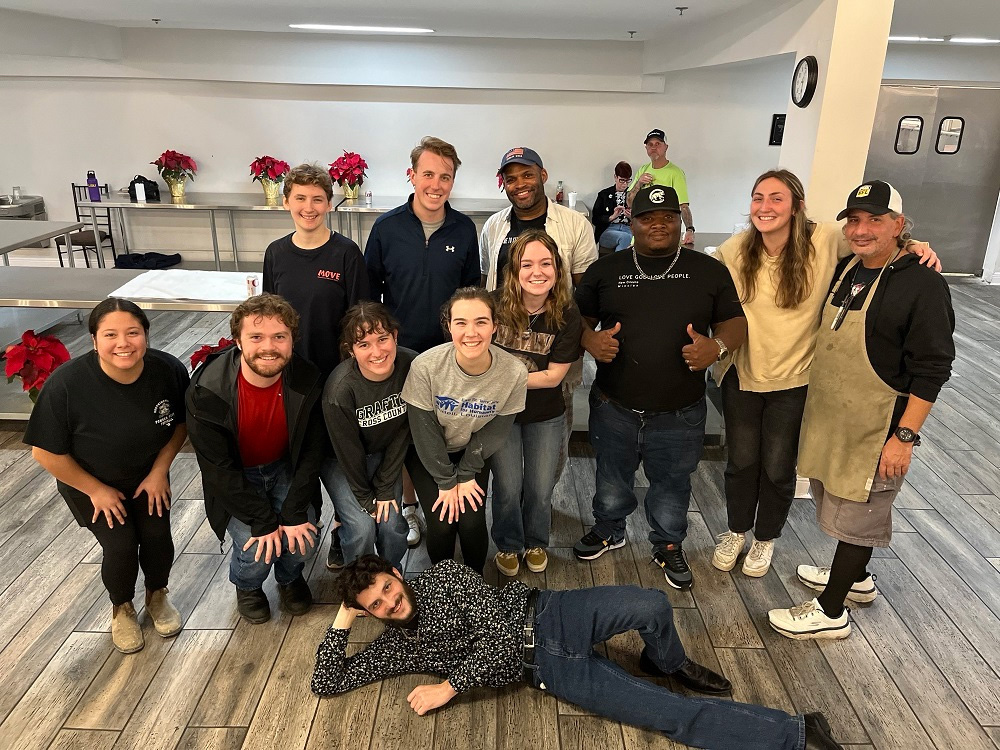Curriculum, opportunities grow along with two gardens
During a break from weeding, composting and planting late in May at the College’s “old” organic garden down the hill from the jug-handle across Route 15 from campus, Amanda Kellner’ 15 got to the root of her interest in the College’s fast-expanding organic gardening operation and related curriculum.
“For me the question is ‘what kind of culture are we trying to cultivate here?’” said Kellner, a recent environmental studies and anthropology graduate. On this particular sunny 8-hour work day, she and two others were planting herbs and preparing beds for transplants – cabbage, broccoli, onions – in the rectangular quarter-acre plot between the railroad tracks and Winooski River, beside a big plastic water tank and a shed with tools and tillers.
“It will be much more exciting when they start coming up,” Kellner said of the day’s plantings. “Food has become a theme throughout all my courses as an Environmental Studies major, and it’s a really active way to be involved in environmental stewardship and social justice.”
She’s working full-time this summer with Jess Reid ’15 of Bridgewater, Jack Loomis ’15 and Erika Bodin ’14 (lead garden project manager for more than two years), to keep the old garden productive while prepping for optimal productivity next year at the new and much larger (1.7 acres) site, around the bend and down from the president’s house. It’s where the Edmundites once grew their “Hunger Garden” in the 1980s.
Supporting their modest salaries to help maintain the plots are donations from campus farm stand sales (stocked by the garden), an Edmundite gift and funds through other campus offices with a stake in garden education. Bodin works full-time, while the others are doing it for summer jobs. They also get lots of volunteer help from the whole community when in season.
Heather Ellis-Lynch, the College’s sustainability coordinator, is excited that 11 Saint Michael’s classes in recent years have used the garden in some way as part of those classes’ curriculum. “Everybody eats,” she says, explaining why the gardens hold such appeal for every segment of the community and make a perfect common ground for education, community-building and service.
Lynch and her helpers say they see a rare window of opportunity in the coming months and years to stake out a place for Saint Michael’s among Vermont’s many colleges that are seeing a burgeoning of popular garden-based offerings as they capitalize on the appealing Vermont “brand” of locavore food production.
She would like to see Saint Michael’s involved in the “Higher Education Food Systems Consortium” – established in 2013 and consisting now of nine Vermont college members who invite students to a summer food-systems tour, stopping at each campus site. “Some places have a niche, say as ‘ag schools,’ but there’s nobody more equipped and capable to talk about food security and justice issues than us,” she says, “so I’d like to cut out our niche in the state. And I believe the window for establishing that reputation and attracting those students who want hands-on experience in permaculture won’t be open too long. I don’t’ want to stay back and be out of the game, and these students want more opportunities for growing things than we can offer at the moment.”
Ellis-Lynch notes that Environmental Studies is an exciting, relatively new program at the College and one of the fastest-growing areas of study on campus with nearly 140 students in the major. “We definitely have the demand, and it ties in perfectly with the growing emphasis here on experiential learning” she said of classes that use the garden in curriculum. “We’ve had ever more request from students and faculty wanting to engage with the garden and we can only do so much with just a quarter-acre. I think it’s going to explode.”
For several years, Brigid Kerr has brought her first-year seminar “Gardens and Greening” to work in the garden, tying writing and reading assignments in with their regular garden work. Her class has been involved in preparing the new site too. Another English class, focused on nature writing, visited the garden several years ago as an assignment prompt.
Others examples from past years of classes using the garden was a “Permaculture Principles” Environmental Studies course that did a solar mapping project to see how the sun lays across the garden landscape in certain seasons. Biology chair Declan McCabe took soil samples from the new site with a class, looking at weed seed content, and hopes to examine animal populations as affected by coming plantings. Peter Hope, also in biology, might try to track birds there before and after plantings, Elllis-Lynch said.
Scott Lewins (biology) had a class called Insects and Society –“bug class” as Lynch calls it, and his students trapped bugs in the garden last year to see what were there, both pests and “beneficials.” Lynch has “pictures of them with big nets.”
Several years ago Mark Lubkowitz (biology) and Valerie Bang-Jensen (education) co-taught a first-year seminar related to a theme of figurative and literal “roots” and brought two sections to get a tour of garden — “to see what we do and why we do it,” Lynch said. In 2013, Karen Popovich (business) brought groups from her classes to develop marketing plans for the College’s garden program. “I loved that one as an outside-the-box collaboration — not just biology and ES, and I see potential for more of that,” Lynch says.
She said Rick Gamache of the Applied Linguistics Department “has been our longest collaboration — every fall semester for past six years he would bring groups of international students who worked on learning English through gardening.” Lynch says soon instructors will be able to reserve raised beds at the new site or “adopt a plot” to grow food for their classes or organizations, much like reserving a library book.
Recently Lynch completed a master’s program in sustainable food systems at Green Mountain College, so she hopes to teach new garden-connected courses herself next year while expanding opportunities for students and instructors to use the garden for learning.
A very recent example was spring semester 2015 when Anjanette DeCarlo, visiting Environmental Studies assistant professor, taught “Special Topics; Permaculture Design Principles” (ES 301), “and it was full with a waiting list,” Lynch says. And a few years ago, two sections of an ES senior seminar “created mini-proposals for the expansion we’re now doing.”
Many other faculty and a few Edmundites have signed on to volunteer for working in the garden and engaging students there on an informal way, says Ellis, who adds she would like to meet with Edmundite Fr. Tom Hoar since he helped run the original Hunger Garden and she hopes to connect to that heritage.
The garden’s anticipated bounty this year already includes lettuce, kale, chard, spinach, snap peas, beans, peppers, eggplants, cantaloupe, watermelon, carrots, cucumbers, zucchini, summer squash, pumpkins, flowers, lots of herbs, scallions, radishes, broccoli, cabbage, Brussels sprouts, and flowers for both pollination and sale at the farm stand – zinnias and sunflowers. “We’ll do a fruit orchard at the new site and berries and a couple nut trees,” she says. “We’re being very purposeful in how we put together and build and grow the new site – our first priority is getting that soil healthy enough to grow all we’ll ask of it – winter rye is there now, and we’re going to experiment with summer cover crops like crimson clover, white clover, peas.
Another potential for the gardens are the student internships it makes possible. “For instance, I’ve had students creating maps of the new site,” Lynch says. “ It will be maybe five years till everything is fully up and ready there, but there’s opportunities to learn, engage and do projects and course work related to preparing the site.”
Erika Bodin, the garden education coordinator, has been at it for two years. She says a highlight has been interacting with those classes that come down. “I’ve worked with two permaculture courses and two first-year seminars so far,” she said. “It’s truly a living-learning classroom. I’m getting to teach the students, but I also learn so much from them.”





